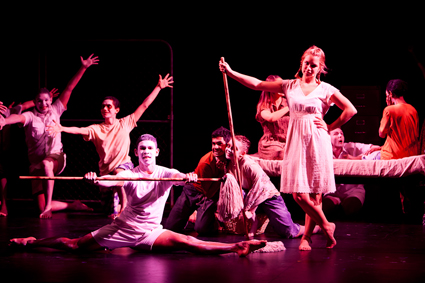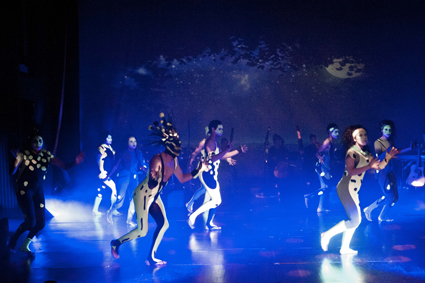show me the culture!
liza-mare syron: aboriginal actor-training

Students from the Aboriginal Centre for the Performing Arts, Brisbane perform Stolen by Jane Harrison, directed by Leah Purcell
photo courtesy ACPA
Students from the Aboriginal Centre for the Performing Arts, Brisbane perform Stolen by Jane Harrison, directed by Leah Purcell
“I EXPECTED TO LEARN ABOUT THE BASIC ACTING SKILLS. I ALSO EXPECTED TO LEARN ABOUT ABORIGINAL HISTORY IN THE PERFORMING ARTS. I ALSO WANTED TO LEARN MORE ABOUT MY CULTURE AND MY PEOPLE IN GENERAL. BEING AN INDIGENOUS PERFORMER IT WAS IMPORTANT FOR ME TO LEARN MY HISTORY, THE ABORIGINAL HISTORY IN PERFORMING ARTS, AND THE PEOPLE WHO HAVE GONE BEFORE ME, MY ROLE MODELS. I BELIEVE THAT INDIGENOUS STORYTELLING AND PERFORMANCE IS A LOT DIFFERENT TO THE SO-CALLED MAINSTREAM PERFORMING ARTS PRACTICE.” SONNY DALLAS LAW, 2010
Many well-established Indigenous theatre practitioners insist that culture is at the heart of their practice. Where then are the opportunities for such an engagement with culture as part of vocational training? Also, insofar as such opportunities do exist, how can we account for the differences between the various professional training programs available to Indigenous actors?
culture, not content
Most Indigenous acting students begin their careers in an Aboriginal-identified actor-training program, with some going on to further training in a mainstream institution. Whatever institution they attend, the way in which Indigenous acting students experience, and make sense of, their training does not depend so much on the specific content or structure of classroom- and studio-based learning; rather, it is essentially defined by the much larger cultural and pedagogical frameworks within which these learning activities are embedded. One of the significant differences between Aboriginal-identified and mainstream actor-training contexts is in the acknowledgement, or not, of culture as meaningful to acting, performance and theatre-making practice for Aboriginal and Torres Strait Islander people.
where to train?
Apart from well known ‘professional’ mainstream actor-training programs at the National Institute of Dramatic Arts (NIDA), Victorian College of the Arts (VCA) and Western Australian Academy of the Performing Arts (WAAPA) there are also three Aboriginal-identified actor-training programs on offer: Eora College in Sydney, New South Wales, the Aboriginal Theatre Certificate IV course at WAAPA and the Aboriginal Centre for Performing Arts (ACPA) in Brisbane, Queensland. Other Indigenous performance-based programs also exist, like Michael Leslie Pilbara Performing Arts and Karratha Community Performing Arts, also in the Pilbara in northern Western Australia, and the Remote Outreach program of Carclew Youth Arts in Adelaide, South Australia. Such programs play a significant role in the actor-training sector because they have a rural and remote reach. More importantly, these programs often inform many of the practices of their city-based counterparts. However, these programs are generally project-based, target young people or are delivered as community development programs. They do not offer ongoing, specifically accredited acting programs for adults, which is the sector under review here.
In regard to the mainstream and Aboriginal-identified institutional actor training programs mentioned, there are many similarities between them, which are mostly more striking than the differences. Of far greater importance are the differences in the cultural context from one institution to another.
aboriginal-identified programs
The Aboriginal-identified programs and institutions are mostly based on the principles of self-determination and self-management. They emerged from Aboriginal community programs originally designed by and for Aboriginal and Torres Strait Islander people. Their primary focus is the education of Indigenous students. These programs generally have core subjects in Aboriginal culture, history and/or values. Many are governed by an Indigenous board or closely monitored by an Aboriginal advisory body. They also employ a significant number of Indigenous teachers and lecturers, and compared to many mainstream programs have a significantly higher Indigenous student population.
culture, informally
Surprisingly, the way in which culture is delivered in an Aboriginal-identified training context is not always by way of structured culture subjects. In fact many of these programs struggle with the delivery of culture as an area of formal study. Instead, culture is mostly exchanged through informal interactions between Indigenous students and staff. Culture is also inherent in the delivery of Indigenous perspectives from Indigenous teachers and guest lecturers. Then, by way of performance, it is enacted, presented and exchanged. In an Aboriginal-identified actor-training program, for the most part, that exchange will take place between Indigenous peoples.
In an Aboriginal-identified actor-training context the culture being enacted, exchanged and experienced retains its integrity. For me the word ‘authentic’ represents a loaded concept; however, in an Aboriginal context, the idea of an authentic or common Aboriginal experience can be explored or experienced through the presence of other Indigenous students and staff.
Some Aboriginal programs also have non-Indigenous student populations and staff. This provides added opportunities for a multiplicity of cultural exchanges to take place. However there are fundamental issues that may arise under these conditions.
culture vs canon

Students from the Aboriginal Theatre ensemble, STRONG by Phillip Walley-Stack, WA Academy of Performing Arts, 2012
photo courtesy WAAPA
Students from the Aboriginal Theatre ensemble, STRONG by Phillip Walley-Stack, WA Academy of Performing Arts, 2012
At mainstream actor-training sites, Indigenous students often, though not always, struggle to some extent to maintain their cultural identity against the dominance of mainstream or Western theatre practices. In this space mainstream programs struggle to know and understand Indigenous culture and its place in mainstream actor training. And for many Indigenous students who attend these programs, the knowable set of dominant theatre practices, mostly framed as ‘mainstream,’ will at some point come to direct the perceived value of their own practices as secondary to mainstream.
cultural specifics vs universals
The ambiguity of the cultural framework underpinning mainstream training contexts can also at times be unsettling for many Indigenous acting students. The idea of a universal acting practice that many mainstream training programs employ (although this is not always clearly articulated) challenges the very core of an Indigenous student’s identity, which is closely aligned with culture and community. Having, in many instances, moved away from family and community to study at a large institution in the big city, the practice of ‘stripping down’ or ‘laying bare’ (or building up) to achieve the ‘neutrality’ of an actor is perceived by some Indigenous students as an act of integration or indoctrination in Western theatre practices. When I asked an Aboriginal graduate from a mainstream training program, “what do the words’ actor training’ mean to you?” the response was:
“Training came to mean that it was a process—I guess assimilation is too much of a loaded term—but a process of being deconstructed and reconstructed into a particular model with a set of expectations that were unclear and changing.”
Both Aboriginal-identified and mainstream actor-training programs offer a range of pedagogical and cultural experiences. For the Indigenous student, these experiences can at times be challenging, and at other times liberating. With many Indigenous acting students beginning their careers in an Aboriginal-identified actor-training program, and with some going on to further training at a mainstream institute, invariably it will be these cultural experiences that define their future acting practice. However the underlying value of culture to that practice cannot be ignored.
looking for cultural engagement
After graduating from both the Eora acting program and from ACPA, Sonny Dallas Law did not go on to study at a mainstream actor training program; he may one day, or he may not. What is important to Sonny however is developing a theatre and performance practice that is meaningful to him, and this means having an approach that is informed by and connected to culture (see page 4). This is not the same for every Indigenous graduate from the Aboriginal-identified acting sector, but in scoping the career pathways of graduates from both mainstream and Aboriginal acting programs I have found that many will attest that they have at some point required some cultural engagement, and this will take the form of either working with other Indigenous people in the process of making theatre, in creating new work, or by portraying Indigenous characters and stories. Also, when Indigenous actors graduate, they are still Indigenous, and they will mostly be required to be so by the industry they graduate into, and by the family they return home to.
incorporating culture
While many Aboriginal-identified actor-training programs see culture as significant to the lives and expression of Indigenous students in general, there can also be improvements in the way culture is incorporated into these programs. This is already something the Indigenous dance-training sector has begun with the development of specific Indigenous dance techniques. There is also a push from ACPA to include voice, language and movement training for performance students based on specific techniques found in Indigenous cultural expression. These developments continue to influence the ever changing cultural landscape that many Indigenous students navigate during their training to be actors, and that will ultimately inform the future of Indigenous performance and theatre-making practices.
RealTime issue #111 Oct-Nov 2012 pg. 16






